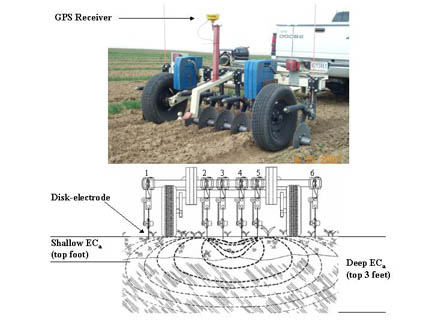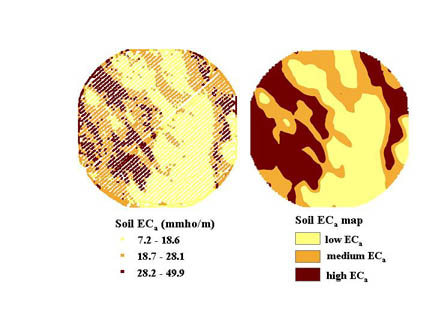by H. J. Farahani, R. Khosla and G.W. Buchleiter* (5/11)
Quick Facts…
- Mapping soil composition across the field is easily done using measurements of soil electrical conductivity (ECa).
- A soil ECa map is important because it identifies areas in a field that have different soil compositions which may benefit from different management strategies.
- The soil EC is a measure of how easily current flows through the soil.
- Because soil properties are relatively constant, a single soil ECa map of a field is sufficient for many years.
Historically, agricultural inputs such as seed, irrigation, fertilizer, and pesticide have been applied evenly over a given field, but the yield at the end of the growing season can vary. Changes in soil texture, organic matter, salinity, subsoil characteristics, and water holding capacity are all factors that can cause changes in yield. Therefore, it is logical, and perhaps more economical, to apply different amounts of agricultural inputs to sections of a field that have different soils. To do this you need accurate maps showing how soil changes across the field. The most informative, simple, least expensive, and accurate map of soil variability across the field is made using measurements of soil electrical conductivity (EC).
What is soil electrical conductivity?
Soil is an electrical conductor. The soil EC is a measure of how easily an electric current flows through the soil. Soil EC responds to the amount of salt in the soil as well as indicates the soil’s composition—the amount of sand, clay, organic matter, and water content.
How is soil EC measured in the field?
One of the simplest devices to measure soil EC in the field is the Veris Soil EC Mapping System (manufactured by Veris Technologies in Salina, Kansas). There are two Veris units commercially available, the 2000XA and the 3100 Soil EC Mapping Systems that are pulled through the field. The Veris units have disks mounted on a toolbar that act as electrodes. The Veris 3100 EC unit (see Figure 1) has six disks and records soil EC readings from two different depths every second. One pair of disk-electrodes induces current into the soil. The change in voltage is measured across the other two pairs of disk-electrodes resulting in simultaneous EC measurements for the top 1 foot of soil and the top 3 feet of soil. The Veris 2000XA unit has four disks and measures soil EC from one depth, but it can be adjusted to read EC for the top 2 to 3 feet of soil.
 |
Figure 1. Veris 3100 EC Mapping System (top) and a diagram of the Veris EC Unit showing the disk-electrodes and electrical network (bottom, reprinted with permission from Veris Technologies). |
To distinguish the EC measured by the Veris unit from the soil science definition of EC (based upon conductance of a saturated soil paste extract), we will call the Veris EC measurement apparent EC (ECa).
A Global Positioning System (GPS) receiver mounted on the Veris unit records the location of each soil ECa measurement point in the field. A field is usually mapped by driving the entire field on parallel paths from 40 to 60 feet apart. With speeds between 8 and 15 mph, the Veris records 50 to 100 soil ECa readings per acre. A 150-acre center pivot field, for example, can be
mapped in 5 to 8 hours giving about 8,000 to 14,000 soil ECa data points. There are number of vendors in Colorado that offers Veris EC mapping services for a nominal fee.
How is a soil ECa map created for a farm field?
The Veris data logger records the soil ECa and GPS data and can be downloaded onto a storage device. Since the Veris unit collects data every second, the Veris ECa file is usually large and therefore best presented graphically as an ECa map. This map allows the user to visualize the ECa differences across the field. The graphical representation of soil ECa data points can be created with any Geographic Information System (GIS) software package. Using the Veris data file and one of the many commercially available GIS software, one can quickly produce a colored map of the field showing the ECa data points as shown on the left in Figure 2. Most GIS software packages can also create a smoother map of ECa (see Figure 2, right). The GIS user can instruct the software to divide the ECa map of the field into zones. For practical purposes, two to five ECa zones are sufficient. For instance, the ECa map in Figure 2 (right) identifies three zones of low, medium, and high ECa.
 |
Figure 2. A color map of individual soil ECa data points (left) and a smooth surface map of soil ECa (right) for a field. |
What does a soil ECa map tell us?
The differences between the soil ECa zones in a field are caused by differences in the soil’s composition (e.g., the amount of sand, clay, and organic matter). A soil ECa map simply shows how soil composition changes across the field, as highlighted by different shades of color for soil ECa zones. Research shows that in most fields, zones with higher ECa values have higher clay and organic matter contents than lower ECa zones. It is always a good idea to collect a few soil cores from each of the ECa zones to determine the amounts of sand, clay and organic matter in each zone. Three to five soil cores (in 1 to 3 foot depths) taken from different locations in each ECa zone are sufficient to determine the level of sand, clay and organic matter in each zone. The light colored areas in the soil ECa map (or the areas that have low ECa values) are usually high in sand and low in clay and organic matter. On the other hand, the darker colored areas on the soil ECa map (or the areas with higher ECa values) have more clay and organic matter and less sand.
How can a soil ECa map be used to make better soil and crop management decisions?
Farmers want to know the composition of their soil so they can apply the correct amount of seeds, fertilizers, and irrigation to each section of their field. Knowing the pattern of soil composition across the field helps farmers and consultants tailor their soil and crop management decisions to fit the soil pattern rather than assuming that the whole field has a uniform composition.
There are economic and agronomic advantages in using soil ECa maps as a guide to make better management decisions. Examples of the most immediate uses of soil ECa measurement and mapping are:
- Rapid identification of farm field variability;
- Guidance to smart soil sampling as opposed to random or grid-based soil sampling;
- Logical placement and interpretation of on-farm tests;
- Development of potential “management zones” for variable rate seeding and chemical application; Identification of coarse-textured zones within the field that are susceptible to leaching;
- Identification of coarse-textured zones within the field that have low water holding capacity and thus susceptible to crop water stress;
- Identification of crop productivity zones based on relative clay and organic matter contents; and
- Further improvement in USDA-NRCS soil maps for various on-farm management decisions.
Does the soil ECa map change over time?
Research shows that soil ECa changes as soil-water content changes, but the patterns of a soil ECa map (Figure 2) stay unchanged from year to year. Since the pattern of a soil ECa map shows changes in soil sand, clay and organic matter, the soil ECa patterns do not change much over time because these soil properties are relatively constant. Therefore, a single soil ECa map of a field is sufficient for many years.
Are there other complementary soil mapping?
There are recent advances in on-the-go mapping of other soil properties of pH and Near Infrared (NIR). A map of soil pH is useful for applying the right amount of lime and could translate to savings as compared to a uniform application across the field. The NIR spectral measurements are claimed to correlate with organic matter, carbon, pH buffer capacity, and soil moisture. Veris Technologies recently added on-the-go soil pH and NIR sensing platforms to its EC mapping system. Researchers and practitioners are further testing these new sensors. Updates to this Crop Series will be provided once the practical utility of the new sensors are documented for a range of soils and field conditions.
Useful Website
- Veris Technologies: https://veristech.com/
*H.J. Farahani, associate professor, soil & water irrigation management, Clemson University (formerly with USDAARS); R. Khosla, Colorado State University Extension precision agriculture specialist; and G.W. Buchleiter, USDA-ARS agricultural engineer. 9/03. Reviewed 5/11.
Colorado State University, U.S. Department of Agriculture, and Colorado counties cooperating. CSU Extension programs are available to all without discrimination. No endorsement of products mentioned is intended nor is criticism implied of products not mentioned.
Go to top of this page.





